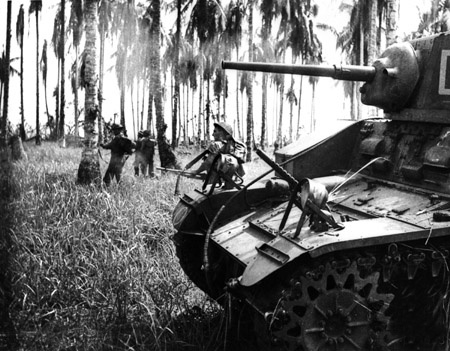Montana’s 163rd Infantry Regiment, 41st Infantry Division, the Jungleers, was called to active duty on September 16, 1940 for one year of training, and on the same day the Selective Training and Service Act of 1940 introduced the first peacetime conscription (for men between 21 and 45) in U.S. history. March 11, 1941: United States President Roosevelt established the Lend Lease Act allowing Britain, China and other allied nations to purchase military equipment and to defer payment until after the war. Roosevelt signed an extension of service of six months for those Americans who had been called up in 1940, such as the 163rd Infantry training at Fort Lewis, Washington. December 7, 1941: The U.S. came under attack by Japanese forces at Pearl Harbor and locations throughout the Pacific. December 8, 1940: The U.S. declared war on Japan. December 11, Germany and Italy declare war on the U.S. The U.S. reciprocates and declares war on Germany and Italy. The largest ever mobilization of American manpower continued, ultimately calling up over 15 million U.S. men and women to serve from 1941 to the end of hostilities in 1945. Over 75,000 Montanans were a part of that force. The 163rd Infantry Regiment served with distinction on the west coast of the U.S. until its departure to Australia in April 1942 as a part of the Southwest Pacific Command going on to fight in the Pacific Theater of World War II. The 163rd Infantry Regiment was recognized as the first U.S. unit to defeat Imperial Japanese Forces in the Battle of Sanananda, Papua, New Guinea in January 1943; subsequently being recognized by the 28th Montana Legislative Assembly by resolution and the famous painting by Irwin ‘Shorty’ Shope in April 1943. The 163rd Infantry Regiment served in the Pacific Theater in three major campaigns: • The Papuan Campaign 1943, winning the battles at Sananada, Gona, and Kumsi River • The New Guinea Campaign 1944, winning the battles of Aitape, Wadke and ‘Bloody” Bia • The Southern Philippines Campaign 1945, wining battles at Zamoanga, Sanga Sanga Island, and the Battle of Jolo and the key village of Calinan The 163rd fought against seasoned Japanese land forces, stopping only because of the cessation of hostilities due to the dropping of the atomic bombs at Hiroshima and Nagasaki, and finally becoming an occupation force on the Japanese mainland. The 163rd was demobilized in Japan, January 1, 1946, and sent home by ships.
Montana’s 163rd Infantry Regiment, 41st Infantry Division


